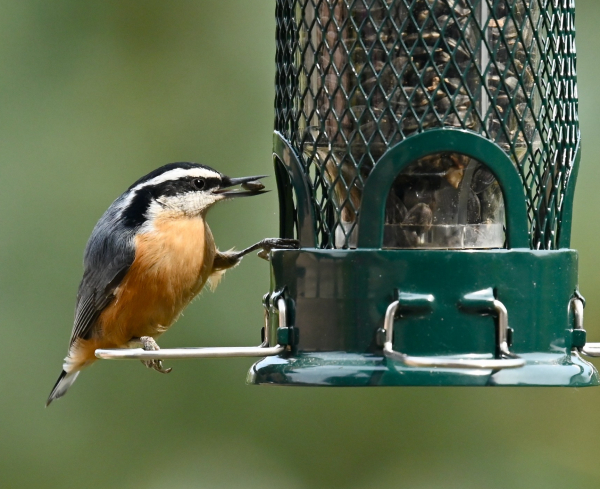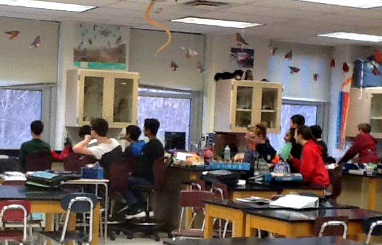
Many students’ interest in birds has sparked a wider interest in science, and the chance to participate in Project FeederWatch has been all the more inviting (Red-breasted Nuthatch photo by Bill Schneider).

Students in Jennifer Ford’s classroom at Farnsworth Middle School in Guilderland, New York are identifying and counting birds to participate in Project FeederWatch. The students are so engaged that Jennifer needs to provide a sign-up sheet for students from outside her regular classes to participate (photo by Jennifer Ford).
|
With Project FeederWatch beginning in just 2 weeks, it’s time for last minute sign-ups. It’s also the best time to start a feeding station at school to involve classes of students to learn about birds. And the luckiest students have a teacher who helps them participate in the fun of FeederWatch as an associated activity to a science class or biology class. A couple bird feeders can add to the learning experience of any age group of students, ranging from preschool through college, and the activity will improve their connection to the nature that surrounds them.
Birds are an interesting and active group of animals that we see every day, and they can add to students’ schooltime experiences in a number of ways. A bird feeding station can be an inspiring and exciting addition outside any classroom window, or at a specially designated area in a schoolyard. A feeding station can be a focus of a science class, but it also can be associated with such classes as geography, art, creative writing, speech, and other subjects. A feeding station is also an excellent addition for a home school project. For more information about basic bird feeding activities, feeders, and bird baths, you can refer to Feeding Birds - FeederWatch
For teachers with a beginning interest in developing a bird-based project, it’s easy to search for information via the internet to learn more about different species of birds, including birds attracted to a new feeding station, at the All About Birds website. Any student can also access a wealth of information about North American bird families and species, and learn about feathers, nesting, bird migration, and much more.
The most appropriate way to get started is if a teacher, an instructor or volunteer who is a birder, or a school administrator introduces the idea of a feeding station project. Although the idea could also be introduced by a student, parent, or someone in the neighborhood who would like to add to the students’ experiences. That would require obtaining the cooperation and interest of a teacher or administrator in the school, and may even require that person (maybe you) to provide a way to pay for a couple different feeders and a bird bath, along with some appropriate food to begin.
In fact, it would be a good idea to organize a funding method in advance, perhaps calling on a local birding club, Audubon chapter, or a local business to provide a bit of financial support for a class or school feeding station. It might be most appropriate to start with a bird bath, suet feeder, and shelled sunflower seed feeder (along with a hummingbird feeder if you have winter hummingbirds in your area).
Birds are the best representatives of our natural world, and their active lives, attractive colors, varied sizes and shapes, and their ability to fly are points of interest that attract us all. It’s aways an advantage to introduce students to live birds beyond a book or website, and any educator will be impressed with the enthusiasm birds can bring to young people. To learn more about Project FeederWatch and the information available from their website for teachers and students – anyone – see How to Participate - FeederWatch. And to learn more about FeederWatch in the classroom, see Educator Resources - FeederWatch
Share your backyard birding experiences and photographs with The Birding Wire at editorstbw2@gmail.com